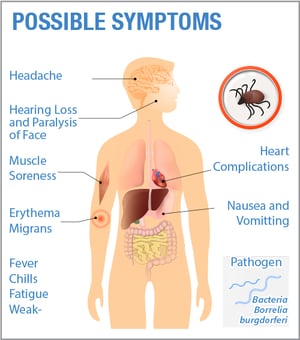| Lyme disease, caused by bacteria transmitted through the bite of infected blacklegged ticks, is a complex illness with a wide range of symptoms that can vary significantly between individuals and over the course of the infection. Early diagnosis and treatment are crucial for preventing long-term complications. This guide provides information for educational purposes only and is not a substitute for professional medical advice. Always consult a doctor for any suspected illness.
Early Stage Lyme Disease (Stage 1: typically 3-30 days post-infection): - Erythema migrans (EM) rash: This is the hallmark symptom, but it doesn't appear in every case. It's a characteristic expanding rash, often bullseye-shaped (but not always), that typically starts at the site of the tick bite. It can be warm to the touch but rarely itchy. It can range in size from a few centimeters to over 30 centimeters. Not all rashes are classic bullseye; some are solid red patches or rings.
- Flu-like symptoms: These can include fever, chills, fatigue, headache, muscle aches, and joint pain. These symptoms can be mild and easily dismissed.
Early Disseminated Lyme Disease (Stage 2: weeks to months post-infection):
If Lyme disease is left untreated, the infection can spread to other parts of the body. Symptoms can include: - Neurological symptoms: These can include facial palsy (Bell's palsy), meningitis (inflammation of the brain and spinal cord), numbness, tingling, and shooting pains.
- Cardiac symptoms: Irregular heartbeat (arrhythmia) and inflammation of the heart muscle (myocarditis) are possible.
- Joint pain (arthritis): Severe joint pain, particularly in the knees, is common. The pain can be migratory (moving from joint to joint).
- Other symptoms: Fatigue, fever, and chills can persist or return.
Late-Stage Lyme Disease (Stage 3: months to years post-infection):
Untreated Lyme disease can lead to chronic, debilitating symptoms: - Severe joint pain (arthritis): Chronic, debilitating joint pain and swelling can occur.
- Neurological problems: These can include persistent neurological symptoms such as memory problems, mood changes, sleep disturbances, and neuropathy (nerve damage).
- Heart problems: Long-term heart damage can result.
- Skin problems: Some individuals may develop skin lesions beyond the initial rash.
Important Considerations: - Not everyone with Lyme disease develops the characteristic rash. Many individuals experience only flu-like symptoms, making diagnosis challenging.
- Symptoms can be vague and mimic other illnesses. This makes accurate diagnosis crucial.
- Diagnosis is made through a combination of symptoms, medical history, and laboratory testing. Testing can include blood tests (ELISA and Western blot) to detect antibodies against the bacteria. However, tests can be negative in early stages of infection.
- Early treatment with antibiotics is highly effective. Delaying treatment can lead to more severe and long-lasting symptoms.
If you suspect you may have Lyme disease, seek immediate medical attention. Early diagnosis and treatment are essential for preventing long-term health problems. This information is for educational purposes only and should not be considered medical advice. Always consult with a healthcare professional for any health concerns. 
Tags: Borrelia Burgdorferi Chronic Illness Erythema Migrans Flu-like Symptoms Healthcare Awareness Lyme Disease Medical Diagnosis Tick-Borne Illness  
|  1,467
1,467  0
0  0
0  3224
3224 